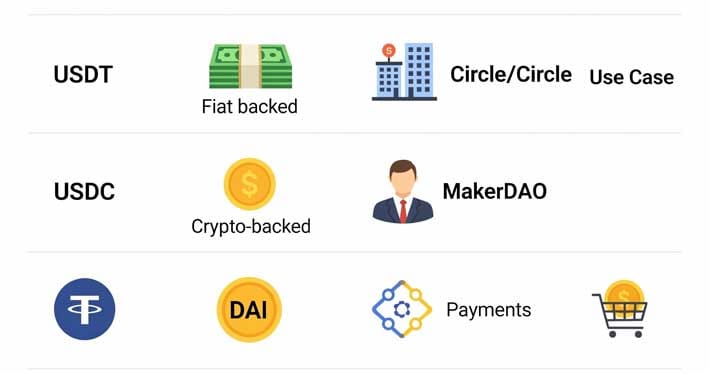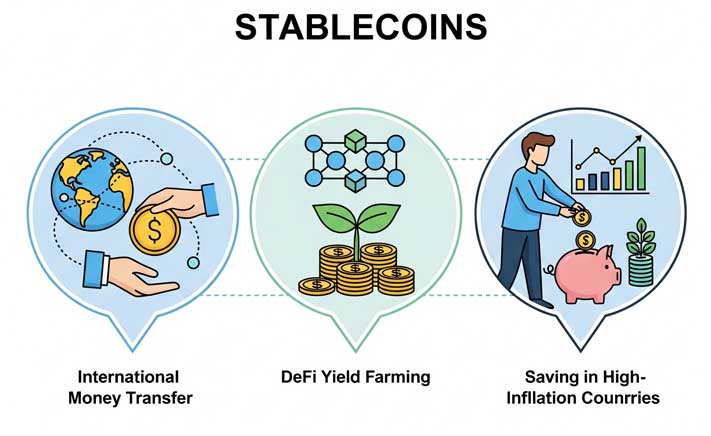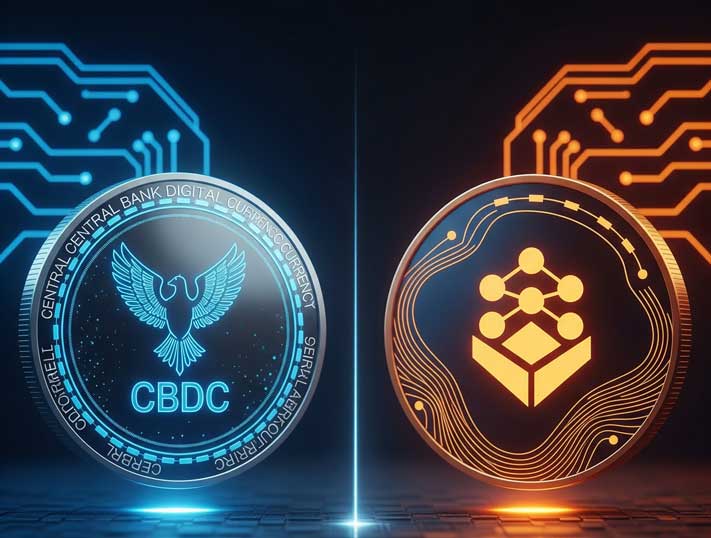In the world of crypto, change happens fast—but stability is rare. That’s where a stable coin comes in. Whether you’re a crypto beginner or just looking for a safer way to store digital value, understanding how stable coins work is a smart first step.
This guide will walk you through everything you need to know about stable coins: what they are, how they keep their value, the most popular ones in 2025, and how they’re used in the real world. Let’s dive in.
What Is a Stable Coin?
A stable coin is a type of cryptocurrency designed to hold a consistent value over time, usually by being backed by a reserve asset like the US dollar or euro. Unlike Bitcoin or Ethereum, which can swing wildly in price, stable coins are built for predictability. They also differ from Central Bank Digital Currencies (CBDCs), which are issued and controlled by national central banks.
There are several types of stable coins. Some are backed by actual fiat currency in a bank (like USDC or USDT), while others use crypto collateral or even algorithms to manage supply and demand. No matter the method, the goal is the same: to stay as close to a fixed value—usually $1—as possible.
These digital assets are used for everything from transferring money across borders to earning interest in Decentralized Finance (DeFi) apps, making them one of the most practical tools in the crypto space.
Why Do Stable Coins Matter?
One of the main reasons stable coins have gained so much attention is their ability to offer price stability in an otherwise highly unpredictable crypto market. Unlike many cryptocurrencies that can experience dramatic swings in value within hours, stable coins provide a dependable alternative—allowing users to hold digital assets without worrying about sudden losses or gains of 20% or more in a single day.
Beyond just stability, these coins simplify the process of moving money swiftly and securely across borders without needing to go through traditional banking channels or financial intermediaries. This makes them especially useful for international transfers where speed and cost are often major concerns.
Additionally, stable coins serve as a convenient trading tool on many crypto exchanges. They act as a reliable medium to buy and sell other digital currencies without having to convert back into fiat money, streamlining the trading experience.
In regions where local currencies face high inflation or economic instability, more people are turning to stable coins as a practical digital alternative to holding traditional dollars or other stable fiat currencies. This growing adoption highlights their role not just as financial tools but also as a means of preserving value in uncertain economic times.
How Stable Coins Maintain Their Value
Keeping a stable value isn’t easy in crypto. Most rely on one of three models:
1. Fiat-Backed
Backed 1:1 by reserves like USD, held in banks. Popular examples include USDC (issued by Circle) and USDT (from Tether). You deposit a dollar, and they issue one token, which can be redeemed for real money.
2. Crypto-Backed
Uses other cryptocurrencies as collateral. One of the best-known is DAI, backed by Ethereum and managed by smart contracts. It’s decentralized and doesn’t rely on banks — but requires over-collateralization to handle price swings.
3. Algorithmic
A more experimental type that uses supply control mechanisms instead of reserves. These systems automatically burn or mint coins to keep the price stable. However, some have failed in the past, like Terra’s UST, highlighting the risks.
Most Popular Stablecoins in 2025
There are now dozens of stable coins available, but only a few have gained widespread trust and usage. Here’s a quick look at the most popular ones in 2025 and what makes each unique.

USDC (USD Coin)
Issued by Circle and fully backed by cash and short-term government bonds, USDC has become one of the most transparent and regulated stable coins in the market. It’s widely used in both retail and institutional crypto transactions. USDC is often preferred by users who care about regulatory compliance and clean auditing practices.
USDT (Tether)
Tether remains the most traded stable coin globally. It’s backed by a mix of reserves, including fiat currency, assets, and sometimes commercial paper. Although Tether has faced criticism over its transparency, its high liquidity makes it a go-to option for traders needing fast movement of large sums.
DAI
DAI is a decentralized stable coin backed by crypto collateral, mostly Ethereum. It’s governed by the MakerDAO protocol, which automatically adjusts the system to keep the token close to the value of one US dollar. DAI appeals to users who prefer decentralized solutions without relying on centralized issuers.
EURC
Not all stable coins are tied to the US dollar. EURC, issued by Circle, is pegged to the euro. It’s becoming more popular in Europe as demand for digital assets tied to local currencies grows.
PYUSD
Launched by PayPal, PYUSD is a stable coin built for payments and backed by dollar reserves. Its integration into PayPal’s vast ecosystem makes it a promising player, especially for e-commerce and peer-to-peer transfers.
How Stable Coins Are Used

Stablecoins have moved far beyond just trading tools. Today, they power a wide range of financial services and applications.
International Payments
Sending money across borders using traditional banking systems can be slow and expensive. These digital assets allow users to transfer value almost instantly, with lower fees and no need to convert between currencies.
Earning Interest in DeFi
Many decentralized finance (DeFi) platforms let users earn passive income by lending or staking them. Since the value stays steady, users don’t face the price volatility risks that come with other cryptocurrencies.
→ Want to understand how DeFi is transforming the financial system? Read our full article on how decentralized finance is changing banking forever.
Saving in Unstable Economies
In countries facing inflation or currency devaluation, people are turning to these tokens as a digital alternative to saving in dollars. They’re easy to store, transfer, and access from a mobile phone — even without a bank account.
Are There Risks With Stable Coins?
While stable coins aim to reduce volatility, they aren’t risk-free. Understanding their limitations is just as important as knowing their benefits.
Reserve Transparency
For fiat-backed coins, the biggest concern is whether the issuer really holds enough reserves. Some companies publish regular audits, while others provide only limited reports, which can raise doubts during times of crisis.
Regulatory Uncertainty
Governments are still figuring out how to regulate stable coins. Some may require licenses or stricter reserve requirements. This could impact availability and usage, especially for cross-border transactions.
Algorithmic Failure
Algorithmic models can fail if they don’t respond well to market stress. The collapse of Terra’s UST in 2022 was a wake-up call. It showed that even stable coins designed to be self-sustaining can unravel quickly without strong mechanisms.
Stable Coin Prices: What Affects Their Value?
At first glance, a stable coin should always be worth exactly one dollar (or whatever currency it’s pegged to). But in practice, prices can vary slightly depending on market demand, liquidity, and trust in the issuer.
On most exchanges, the price of a stable coin might hover just above or below its peg—for example, $0.998 or $1.002. This is usually normal and reflects supply and demand. In times of heavy trading, redemption delays, or uncertainty about reserves, the gap can widen.
Some stable coins also face pressure when market confidence drops. If people start selling off their tokens faster than they can be redeemed, prices can slip. That’s why coins with clear, audited reserves tend to hold their peg better under stress.
In decentralized models like DAI, price stability relies on automated systems. These can be more flexible but also come with their own risks if the underlying collateral suddenly loses value.
The Future of Stable Coins: Regulation, Adoption, and CBDCs

The future of stable coins looks promising—but also more regulated. Governments around the world are taking a closer look at how these digital assets operate and how they fit into the financial system.
In the United States and Europe, new rules are being discussed that would require stable coin issuers to prove they hold full reserves and meet licensing requirements. This could increase trust but may also limit which coins remain on the market.
At the same time, central banks are exploring digital currencies of their own—called central bank digital currencies (CBDCs). While some see them as competition, others believe CBDCs and stable coins can coexist. One may serve as a public infrastructure, while the other powers innovation in private apps and platforms.
As stable coin technology becomes more integrated into everyday apps and payment systems, adoption will likely grow beyond just crypto users. PayPal, Visa, and other mainstream players are already experimenting with it—making stable coins more visible and practical for average consumers.
Conclusion: Why Stable Coins Matter in 2025 and Beyond
Stable coins are no longer a side note in the crypto world. They’ve become essential tools for trading, saving, transferring money, and building new financial systems—especially in regions where traditional banking falls short.
While no digital asset is entirely risk-free, stable coins offer something rare in crypto: predictability. And in an uncertain world, that makes them more valuable than ever.
As regulations tighten and new players enter the space, stable coins are likely to evolve—becoming even more reliable, widely accepted, and useful in everyday life.
Further Reading and Insights
For those seeking a deeper and more technical understanding of stable coins, their risks, and the evolving regulatory landscape, the Bank for International Settlements (BIS) offers one of the most comprehensive and authoritative reports available. Their analysis sheds light on how stable coins fit into the global financial system and the challenges policymakers face in ensuring stability and security. Exploring this resource can provide valuable insight into the future direction of digital currencies and their impact on traditional finance.
You can read the full BIS report here: Stablecoins: Risks, Potential and Regulation.












